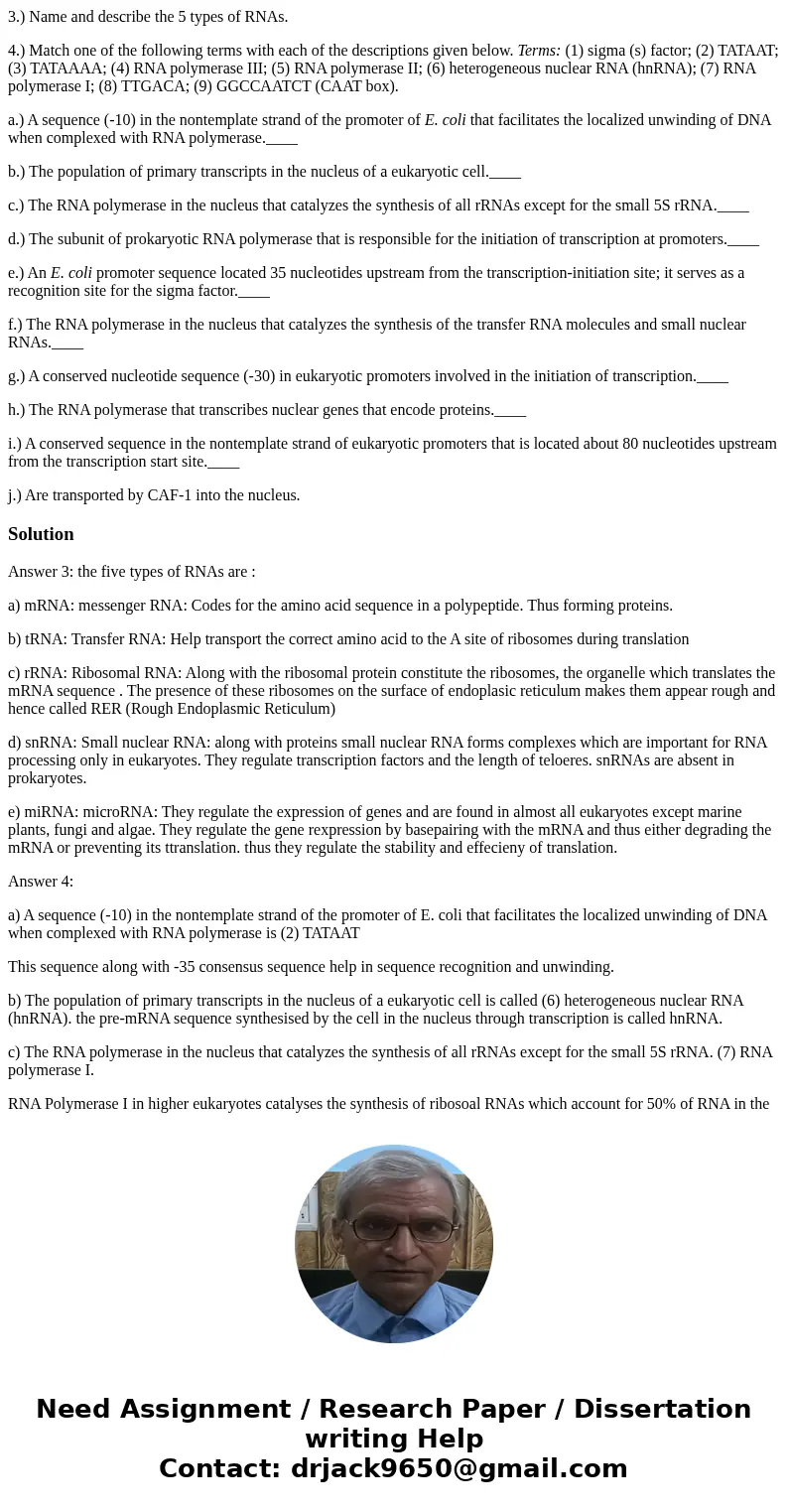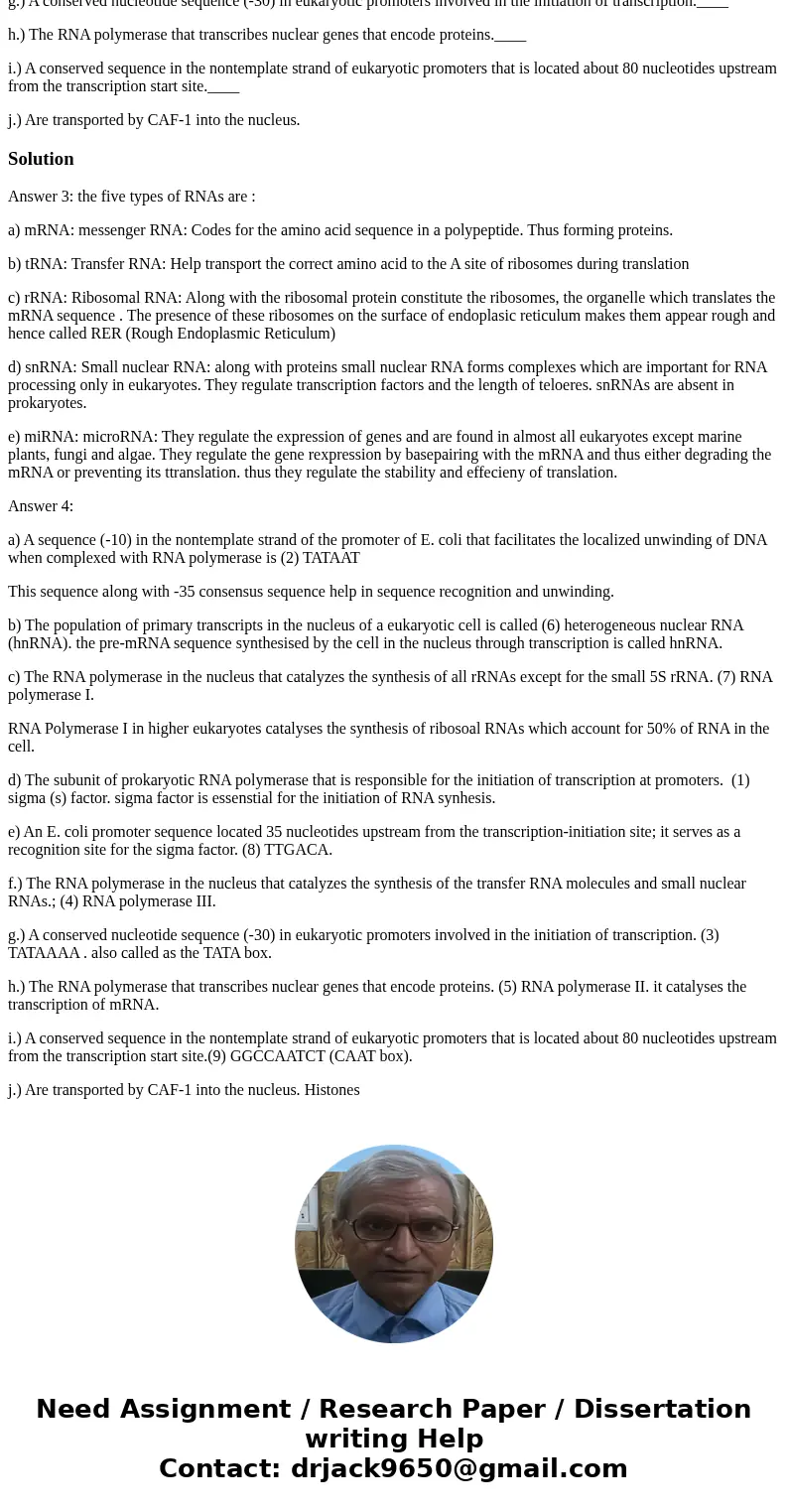3 Name and describe the 5 types of RNAs 4 Match one of the f
3.) Name and describe the 5 types of RNAs.
4.) Match one of the following terms with each of the descriptions given below. Terms: (1) sigma (s) factor; (2) TATAAT; (3) TATAAAA; (4) RNA polymerase III; (5) RNA polymerase II; (6) heterogeneous nuclear RNA (hnRNA); (7) RNA polymerase I; (8) TTGACA; (9) GGCCAATCT (CAAT box).
a.) A sequence (-10) in the nontemplate strand of the promoter of E. coli that facilitates the localized unwinding of DNA when complexed with RNA polymerase.____
b.) The population of primary transcripts in the nucleus of a eukaryotic cell.____
c.) The RNA polymerase in the nucleus that catalyzes the synthesis of all rRNAs except for the small 5S rRNA.____
d.) The subunit of prokaryotic RNA polymerase that is responsible for the initiation of transcription at promoters.____
e.) An E. coli promoter sequence located 35 nucleotides upstream from the transcription-initiation site; it serves as a recognition site for the sigma factor.____
f.) The RNA polymerase in the nucleus that catalyzes the synthesis of the transfer RNA molecules and small nuclear RNAs.____
g.) A conserved nucleotide sequence (-30) in eukaryotic promoters involved in the initiation of transcription.____
h.) The RNA polymerase that transcribes nuclear genes that encode proteins.____
i.) A conserved sequence in the nontemplate strand of eukaryotic promoters that is located about 80 nucleotides upstream from the transcription start site.____
j.) Are transported by CAF-1 into the nucleus.
Solution
Answer 3: the five types of RNAs are :
a) mRNA: messenger RNA: Codes for the amino acid sequence in a polypeptide. Thus forming proteins.
b) tRNA: Transfer RNA: Help transport the correct amino acid to the A site of ribosomes during translation
c) rRNA: Ribosomal RNA: Along with the ribosomal protein constitute the ribosomes, the organelle which translates the mRNA sequence . The presence of these ribosomes on the surface of endoplasic reticulum makes them appear rough and hence called RER (Rough Endoplasmic Reticulum)
d) snRNA: Small nuclear RNA: along with proteins small nuclear RNA forms complexes which are important for RNA processing only in eukaryotes. They regulate transcription factors and the length of teloeres. snRNAs are absent in prokaryotes.
e) miRNA: microRNA: They regulate the expression of genes and are found in almost all eukaryotes except marine plants, fungi and algae. They regulate the gene rexpression by basepairing with the mRNA and thus either degrading the mRNA or preventing its ttranslation. thus they regulate the stability and effecieny of translation.
Answer 4:
a) A sequence (-10) in the nontemplate strand of the promoter of E. coli that facilitates the localized unwinding of DNA when complexed with RNA polymerase is (2) TATAAT
This sequence along with -35 consensus sequence help in sequence recognition and unwinding.
b) The population of primary transcripts in the nucleus of a eukaryotic cell is called (6) heterogeneous nuclear RNA (hnRNA). the pre-mRNA sequence synthesised by the cell in the nucleus through transcription is called hnRNA.
c) The RNA polymerase in the nucleus that catalyzes the synthesis of all rRNAs except for the small 5S rRNA. (7) RNA polymerase I.
RNA Polymerase I in higher eukaryotes catalyses the synthesis of ribosoal RNAs which account for 50% of RNA in the cell.
d) The subunit of prokaryotic RNA polymerase that is responsible for the initiation of transcription at promoters. (1) sigma (s) factor. sigma factor is essenstial for the initiation of RNA synhesis.
e) An E. coli promoter sequence located 35 nucleotides upstream from the transcription-initiation site; it serves as a recognition site for the sigma factor. (8) TTGACA.
f.) The RNA polymerase in the nucleus that catalyzes the synthesis of the transfer RNA molecules and small nuclear RNAs.; (4) RNA polymerase III.
g.) A conserved nucleotide sequence (-30) in eukaryotic promoters involved in the initiation of transcription. (3) TATAAAA . also called as the TATA box.
h.) The RNA polymerase that transcribes nuclear genes that encode proteins. (5) RNA polymerase II. it catalyses the transcription of mRNA.
i.) A conserved sequence in the nontemplate strand of eukaryotic promoters that is located about 80 nucleotides upstream from the transcription start site.(9) GGCCAATCT (CAAT box).
j.) Are transported by CAF-1 into the nucleus. Histones


 Homework Sourse
Homework Sourse